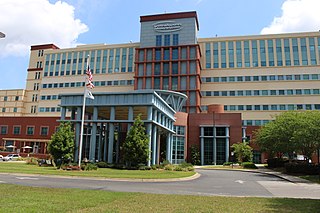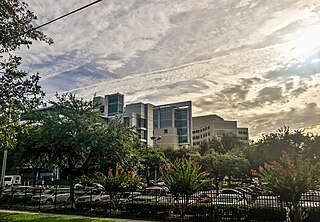
Danbury Hospital is a 456-bed hospital in Danbury, Connecticut serving patients in Fairfield County, Connecticut, as well as Westchester County and Putnam County, New York.

Rose Medical Center is a part of HCA Healthcare's HealthONE network. With thousands of babies born each year, Rose is colloquially known as Denver's "Baby Hospital." It also provides comprehensive women's care, orthopedics and total joint replacement, heart and vascular care, weight-loss treatment, cancer care, surgical services, internal medicine and emergency care. Ryan Tobin is the President and Chief Executive Officer.

Capital Regional Medical Center is a hospital in Tallahassee, Florida, United States. A fully accredited healthcare facility, it has more than 1,100 employees, approximately 500 physicians, and 266 beds. It includes a Bariatric Center, Comprehensive Breast Center, Cancer Center, Family Center, Accredited Chest Pain Center w/PCI, 24/7 Emergency Services in Leon & Gadsden Counties, Certified Primary Stroke Center, Surgical Services, Heart & Vascular Center, Wound Care Center, Seniors First and affiliated physician practices.

University Hospitals Portage Medical Center is a 117-staffed-bed hospital located in Ravenna, Ohio, United States, that serves the residents of Portage County and surrounding communities. Affiliated with University Hospitals of Cleveland, the hospital includes an urgent care facility, surgery center, comprehensive imaging facilities, and a network of physician practices. It offers surgical, women's and emergency services, as well as cancer and respiratory care. It was founded in 1894 as White Hospital and became the Portage County Hospital in 1917. From 1932 to 2015 it was known as Robinson Memorial Hospital.

UF Health Jacksonville is a teaching hospital and medical system of the University of Florida in Jacksonville, Florida, United States. Part of the larger University of Florida Health system, it includes the 603-bed UF Health Jacksonville hospital, the 92-bed UF Health North hospital, associated clinics, and is the Jacksonville campus of UF's Health Science Center. Together with UF Health Shands Hospital in Gainesville, UF Health Jacksonville is one of two academic hospitals in the UF Health system, and serves 19 counties in Florida and several in Georgia.
MedStar Health is a not-for-profit healthcare organization. It operates more than 120 entities, including ten hospitals in the Baltimore–Washington metropolitan area of the United States. In 2011 it was ranked as the employer with the largest number of local employees in the region.
St. Cloud Hospital is a hospital in St. Cloud, Minnesota, United States. It is a Catholic-affiliated, not-for-profit institution and part of the CentraCare Health System. The hospital has more than 9,000 employees, 400 physicians and 1,200 volunteers. It serves 690,000 people in a 12-county area.

Baptist Health is a faith-based, non-profit health system comprising 7 hospitals with 1,168 beds, a cancer center, four satellite emergency departments and more than 200 patient access points of care, including 50 primary care offices located throughout northeast Florida and southeast Georgia. The headquarter is in Jacksonville, Florida.

The Erlanger Health System, incorporated as the Chattanooga-Hamilton County Hospital Authority, a non-profit, public benefit corporation registered in the State of Tennessee, is a system of hospitals, physicians, and medical services based in Chattanooga, Tennessee. Erlanger's main location, Erlanger Baroness Hospital, is a tertiary referral hospital and Level I Trauma Center serving a 50,000 sq mi (130,000 km2) region of East Tennessee, North Georgia, North Alabama, and western North Carolina. The system provides critical care services to patients within a 150 mi (240 km) radius through six Life Force air ambulance helicopters, which are equipped to perform in-flight surgical procedures and transfusions.
Community Hospice & Palliative Care, also known simply as Community Hospice, is a not-for-profit hospice, which has served the Greater Jacksonville Metropolitan Area since its inception in 1979. The organization was the first hospice program in Northeast Florida and one of a few operating programs in the state when Florida began granting hospice licenses in 1981; Community Hospice received their license in 1983 and in 2008, assisted nearly 1,000 patients daily and more than 6,000 patients a year.

Grinnell Regional Medical Center (GRMC) is an American private, nonprofit and non-tax supported 49-bed rural community hospital in Grinnell, Iowa. With 50 physicians and allied healthcare professionals, 400 employees, and more than 300 volunteers, it serves an estimated 47,000 residents in east-central Iowa in the counties of Poweshiek, Jasper, Benton, Iowa, Mahaska, and Tama. GRMC is located at 210 Fourth Avenue in Grinnell.
Montefiore New Rochelle Hospital is a community-based, teaching hospital located at 16 Guion Place in the West End of the city of New Rochelle, in Westchester County, New York, and affiliated with the Albert Einstein College of Medicine. The hospital opened on Huguenot Street in 1892 as New Rochelle Hospital. On November 6, 2013, Sound Shore was acquired by the Bronx-based Montefiore Medical Center, the University Hospital for the Albert Einstein College of Medicine, was renamed Montefiore New Rochelle Hospital, and became part of the Montefiore Health System.
The Florida Georgia Blood Alliance (FGBA) was non-profit community blood bank that supplies blood to northeast Florida and southeast Georgia. The alliance began in Jacksonville, Florida, in 1942 under the name of the Jacksonville Blood Bank. In the 1980s, it expanded to include southeast Georgia, becoming the Florida Georgia Blood Alliance in the process. In 2001, it began serving the Memorial Health University Medical Center in Savannah, Georgia, and opened a Community Donor Center. It also served the Low Country area of South Carolina as The Blood Alliance.

McLaren Flint is a nonprofit, 378 bed tertiary teaching hospital located in Flint, Michigan. McLaren is affiliated with the Michigan State University College of Human Medicine's medical residency programs, including family medicine, internal medicine, general surgery, orthopedic surgery and radiology. McLaren also maintains a hematology/oncology fellowship program in partnership with Michigan State University and is sponsoring a surgical oncology fellowship program. McLaren Flint is a subsidiary of McLaren Health Care Corporation.
BJC HealthCare is a non-profit health care organization based in St. Louis, Missouri. BJC includes two nationally recognized academic hospitals – Barnes–Jewish Hospital and St. Louis Children's Hospital, which are both affiliated with the Washington University School of Medicine.

AdventHealth Celebration is an acute care hospital in Celebration, Florida. The 315,000-square-foot (29,300 m2) 220-bed acute-care facility serves visitors to the Walt Disney World, and is the community hospital for Greater Orlando and a major tertiary referral hospital for Central Florida.

The University of Florida College of Medicine – Jacksonville is the largest of the three University of Florida Health Science Center Jacksonville colleges — medicine, nursing and pharmacy. The college's 16 clinical science departments house more than 440 faculty members and 380 residents and fellows. The college offers 34 accredited graduate medical education programs and 10 non-standard programs.
St. Vincent's HealthCare, based in Jacksonville, Florida is a network of three acute-care hospitals, a long-term skilled nursing facility, 30+ primary care centers, nearly a dozen medical laboratories, transportation and prescription services, and a health outreach ministry. It is part of Ascension, the largest Catholic hospital system in the United States.

Penrose Hospital is a 364-bed hospital hospital located in Colorado Springs, Colorado and owned by Penrose-Saint Francis Health Services. The campus includes Penrose Hospital, the Penrose Cancer Center, the E Tower building, the Penrose Pavilion, and John Zay House.

Middlesex Hospital is a non-profit, acute care community hospital in Middletown, Connecticut.















